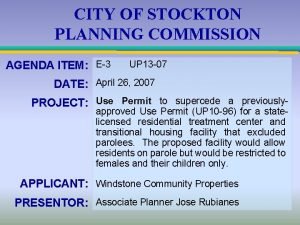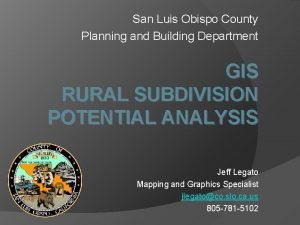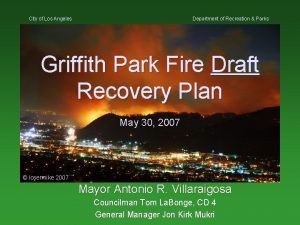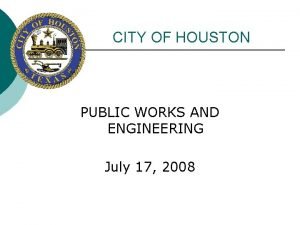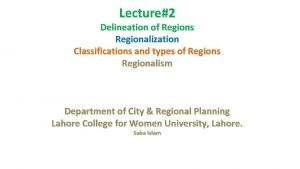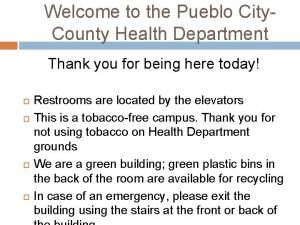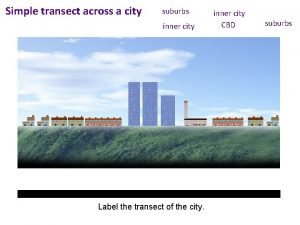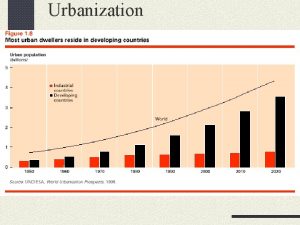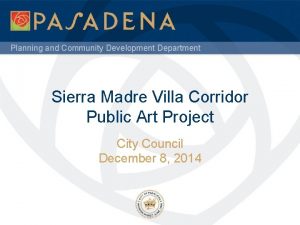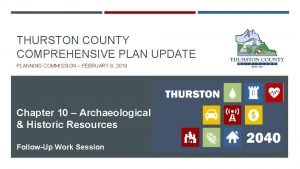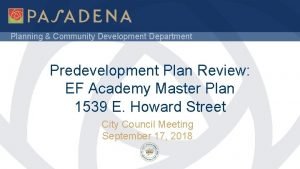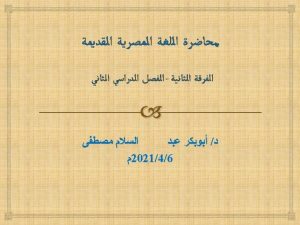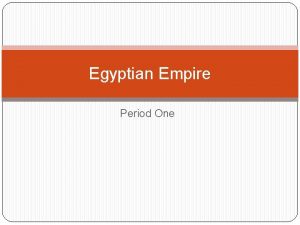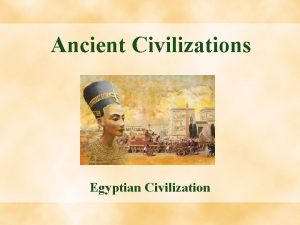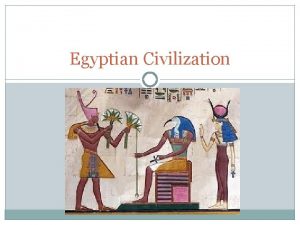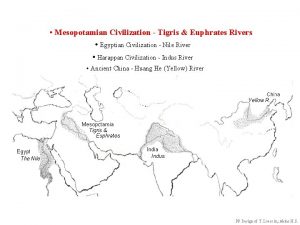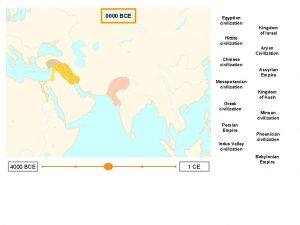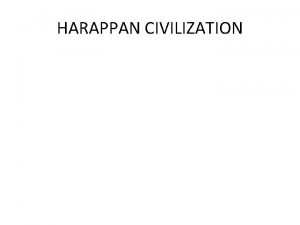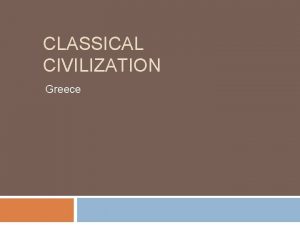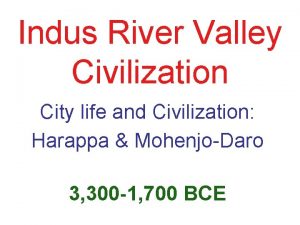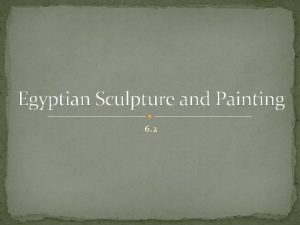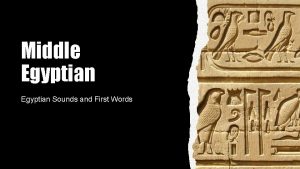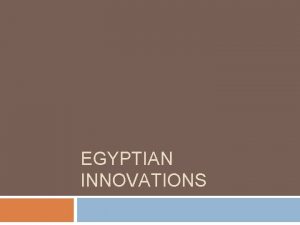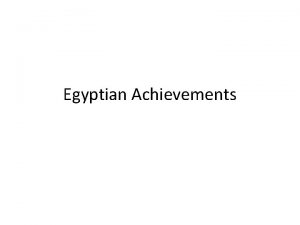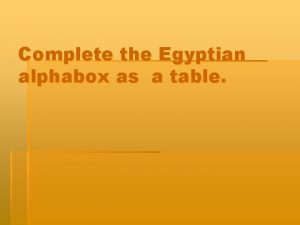Egyptian Civilization CITY AND REGIONAL PLANNING DEPARTMENT LCWU


































- Slides: 34

Egyptian Civilization CITY AND REGIONAL PLANNING DEPARTMENT, LCWU


Where is Egypt? • Egypt is on the continent of Africa. • The River Nile runs through Egypt • The capital of Egypt is Cairo

Where is Egypt?

GEOGRAPHY… • The Egyptians, like the Mesopotamians, settled near a river because of the benefits and contributions it gave. • Do you remember some of the reasons? – – – Travel Trade Irrigation for crops Water for drinking and cooking Yearly flooding, which left behind rich, fertile soil. Egypt’s settlement arose along narrow strip of land made fertile by the river.

THE NILE RIVER VALLEY • The Nile is the longest river in the world – almost 4, 000 miles long!! • It is shaped like the lotus flower so often seen in ancient Egyptian art. • The Nile flows from south to north because of the geography of the land. • Mountains are to the south and low lying plains are in the north. • As the water comes down the mountains it flows through the river delta and empties into the Mediterranean Sea.

NATURAL BARRIERS OF PROTECTION • The ancient Egyptians enjoyed many natural barriers against invaders. • There were deserts to the east and west of the Nile River, and mountains to the south. • This isolated the ancient Egyptians and allowed them to develop a truly distinctive culture. • Reduced interaction with other people. • Other natural barriers included the Mediterranean Sea to the north and the Red Sea to the east.

THE NILE RIVER VALLEY • Civilization started along the Nile about 5, 000 years ago. Without the Nile, Egypt would be a desert because it rarely rains. • Each spring, water would run off the mountains and the Nile would flood. • As the flood waters receded, black rich fertile soil was left behind. • The ancient Egyptians called this rich soil ‘The Gift of the Nile. ’ • Egyptians celebrated the 3 stages: • Flood (flooding which usually lasted 4 months) • Emergence (planting & growing) • Harvest (collecting the food) • The area after flooding is called “black land” because of the nutrient-rich soil created by silt (Because of this black represented life and was often used in statues showing the afterlife. ) • The surrounding desert area is known as the “red land”.

GIFTS OF THE NILE Fertile soil for crops was not the Nile's only gift. The Nile gave the ancient Egyptians many gifts. • Thanks to the Nile, these ancient people had fresh water for drinking, Fishing and bathing. • The Nile supported transportation and trade. • It provided materials for building, for making cloth for clothes, and even for making paper - made from the wild papyrus weed, that grew along the shores of the Nile. • The Nile was unfortunately also a taker of life. – Many people accidentally drowned. – Extreme rainfall washed away crops. – Light flooding resulted in poor soil and crops would not grow.

PHARAOHS & GODS • GOVERNMENT and RELIGION were inseparable in ancient Egypt. The Egyptians believed their pharaoh was both a god and a king. • They also believed that animals, especially the cat, were sacred and deserved to be worshipped. • Religion and government brought order to society through: – The construction of TEMPLES – The creation of LAWS – TAXATION – The ORGANIZATION OF LABOR – TRADE with neighbors

MUMMIFICATION AND THE GODS • • Osiris, the god of the dead, and Isis, his sister/wife and goddess of nature, were also important. Egyptians considered the afterlife more important than the time spent on earth. Because of this, they gave great thought to burial of the dead. The body was preserved in salts and spices and then wrapped in linen. This mummy was then placed into a wooden coffin, sometimes made of pure gold. Amulets or jewels were then placed on the body. Adults were buried with furniture, artwork, and pottery. Children were buried with toys. This gave the dead items to keep them happy in the afterlife. The sarcophagus was then placed into the pyramid tombs to enjoy their time in the afterlife.

Draw the Egyptian social pyramid.

Upper and Lower Egypt • Remember the mountains and flat plain of Egypt’s geography? – Southern Egypt is called Upper Egypt (located high in the mountains) • The pharaoh of Upper Egypt wore a white crown. – Northern Egypt is called Lower Egypt (located in the plain next to the Mediterranean Sea. • The pharaoh of Lower Egypt wore a red crown • King Narmer united Upper and Lower Egypt and also the crown.

A mural of Narmer or Menes conquering Lower Egypt (c. a. 3100 B. C. )

The 3 Kingdoms of Egypt The ancient Egyptian timeline is divided into three big blocks of time – the Old Kingdom, the Middle Kingdom, and the New Kingdom.

The Old Kingdom The Pyramid Age (500 years) 1. Pharaohs had absolute power and were considered to be gods on earth. 2. King Narmer (Menes) unified Upper and Lower Egypt. 3. Pyramids, including the Great Pyramid of Giza, are built to serve as tombs for the pharaohs. 4. Mummification was used to preserve dead bodies.

The Middle Kingdom The Golden Age (300 years) 1. 2. 3. 4. 5. Pharaohs should be “good kings”; wise and gifted rulers. Built strong armies and fortresses. Egypt conquered Nubia and invaded Syria and Palestine. Literature and the arts expanded and greatly improved through contact with trading countries. Pharaohs were buried in secret places.

The New Kingdom The Empire (500 years) 1. 2. 3. 4. 5. Pharaohs should be all powerful; great kings and queens. Created an empire through force and military conflict. The first female pharaoh, Hatshepsut, ruled. The Valley of the Kings is created; all pharaohs are buried here. Egyptians become monotheistic.

Steps to Building a Pyramid 1. The enormous limestone blocks were taken off the boats near the pyramid site. If one block accidentally fell, it could crush to death hundreds of people. 2. Once unloaded, the limestone blocks were hauled on sledges over wooden rollers by gangs of men. Water or milk was poured around the sledges to help them slide. 3. Ramps, built of mud brick, were used to haul the heavy stones to the level where building was going on. To raise the stones higher.

Location of the Pyramids Religious and practical reasons controlled where the pyramids were built. 1. Pyramids had to be on the west side of the Nile River, where the sun set. 2. They had to be built close to the Nile so boats could carry the stones to the construction site. 3. They had to be built high above the level of the river so no damage would occur during the flood season. 4. Each side of the pyramid had to face one of the four cardinal points – north, south, east, and west. 5. A pyramid had to be close to the pharaoh’s palace so he could keep any eye on his “castle of eternity”.

The Pyramid of Meydum The Great Pyramids of Giza The Bent Pyramid

Egyptian Writing • Over 5000 years ago, the ancient Egyptians wrote things down using a picture writing called hieroglyphics. • The people who did the actual writing were called scribes. • The ancient Egyptians believed that it was important to record and communicate information about religion and government.

Writing and language of Egypt • How do we know so much about the Egyptians? – Because they loved to write! • Egyptians, mainly scribes, wrote laws, trade records, ruling family information, and myths and legends using hieroglyphics. • Another “gift” from the Nile River was papyrus made from the reeds that grew alongside the banks of the river. • Egyptians harvested the papyrus and flattened the pulp from the center of the reeds into sheets of paper. • On these sheets were the recordings of the scribes.

Rosetta Stone • Over time the Egyptian method of writing changed from one form to another. As it changed, more and more people forgot how to read the hieroglyphics. • Finally around 1800 CE, a stone was found called the Rosetta Stone. • On the stone there were three kinds of writing telling the same story. – At the bottom was Greek (which the archaeologists could read) – In the middle was Demotic-a later Egyptian writing (which could be read too) – At the top was hieroglyphics. Archaeologists could translate it based on the meanings, words, and symbols from the other two languages!


Most HOUSES were made of BRICK. The banks of the Nile provided the mud used to make bricks. Brick makers collected MUD, added STRAW and WATER to it as needed, and stomped it with their feet until it reached the right consistency. The mixture was then placed in a MOLD. Once shaped, the bricks were removed from the mould and left on the ground to dry in the sun. Egyptian PEASANTS would have lived in SIMPLE MUD-BRICK HOMES containing only a few pieces of furniture: BEDS, STOOLS, BOXES and LOW TABLES.

CRAFTWORKERS lived in one- or two-storey FLAT-ROOFED DWELLINGS made of mud bricks. The walls and roof would have been covered with plaster and painted. Inside, there was a RECEPTION ROOM, a LIVING ROOM, BEDROOMS and a CELLAR in which food and beverages were stored. Food was prepared in an OUTDOOR KITCHEN equipped with a mud-brick oven. Stairs on the exterior of the house led to a ROOF-TOP TERRACE.

The HOMES OF THE WEALTHY were larger and more luxurious. SPACIOUS reception and living rooms opened onto a CENTRAL GARDEN COURTYARD with a fish pond and flowering plants. Each bedroom had a PRIVATE BATHROOM, and the walls, columns and ceilings were painted with BEAUTIFUL DESIGNS inspired by nature. Elaborate and highly DECORATED FURNITURE included beds, chairs, boxes and tables. PAINTED CLAY POTS and vessels, as well as ALABASTER BOWLS AND JARS, were also found in the homes of the nobles.

A villa from the city of Amarna


CITY PLANNING • The cities of Ancient Egypt developed along the Nile River due to the fertile farmland along its banks. • The typical city had a wall around it with two entrances. • The outlay of the city itself was rectangular with an orthogonal street grid, covering an area of 350 by 400 meters. • The streets all over the city were laid out in approximately straight lines. The alleys leading to the workers' dwellings ended in culs-de-sac. • There was a major road down the center of the town with smaller, narrow streets connecting to it. • The houses and buildings were made of mud-brick. • If a building was destroyed in a flood, generally a new building was just built on top of it.

• The mud-brick buildings were susceptible to water and damp conditions so care had to be taken when considering the placement of a house, town or city. When houses did crumble, new houses were simply built upon the ruins of the former house. This led to houses and towns being built on a more elevated plain.

ACHEIVMENTS MATHEMATICS: Although the Egyptians lacked the symbol for zero, they calculated numbers based on the DECIMAL and the repetitive (numbers based on the POWER OF 10). The following signs were used to represent numbers in the decimal system 1 10 1000 10, 000 100, 000 1, 000 Numbers were usually written LEFT TO RIGHT, starting with the highest denominator The Egyptians did not develop abstract mathematical formulas. They used the simple arithmetic of ADDITION AND SUBTRACTION

MEDICINE: The doctors of ancient Egypt combined MAGIC SPELLS with REMEDIES. If a person fell sick, the illness was thought to be caused by the wrath of the gods or by an evil spirit that had entered the body. Both PRIESTS AND DOCTORS were called upon to heal the sick, combining their powers and skills to fix the problem. Doctors found cures for many diseases and some of their concepts are still used today. They used CASTOR OIL as laxatives, TANNIC ACID from the acadia tree to heal burns, CORIANDER in a tea for stomach illnesses, and CUMMIN SEEDS on aching or arthritic joints and to calm a cough. They also made and used TOOLS FOR SURGICAL USE that are similar to the ones that we use today.
 Egyptian floral arrangements
Egyptian floral arrangements Ancient egyptian clothing for special occasions
Ancient egyptian clothing for special occasions How long egyptian civilization lasted
How long egyptian civilization lasted Stockton planning commission
Stockton planning commission San luis obispo county planning department
San luis obispo county planning department City of cupertino planning department
City of cupertino planning department City of los angeles department of recreation and parks
City of los angeles department of recreation and parks Nyc youth and community development
Nyc youth and community development City of houston engineering department
City of houston engineering department Delineation of formal region
Delineation of formal region Champaign regional planning commission
Champaign regional planning commission Location planning analysis
Location planning analysis Southern nevada regional planning coalition
Southern nevada regional planning coalition City of ekurhuleni energy department
City of ekurhuleni energy department City of palm coast water department
City of palm coast water department City tech math department
City tech math department Tuba city fire department
Tuba city fire department City of atlanta department of public works
City of atlanta department of public works City of hamilton public works department
City of hamilton public works department Pueblo city county health department
Pueblo city county health department Pasadena city college police department
Pasadena city college police department Anchor point fire vancouver
Anchor point fire vancouver City of houston finance department
City of houston finance department History of latin american city model
History of latin american city model Cbd inner city outer city
Cbd inner city outer city Primate cities
Primate cities Telangana development planning society
Telangana development planning society Succession
Succession Sierra madre planning department
Sierra madre planning department Siskiyou county planning department
Siskiyou county planning department Thurston county planning commission
Thurston county planning commission Skagit county critical areas map
Skagit county critical areas map Pefht
Pefht Pasadena planning department
Pasadena planning department Temecula planning department
Temecula planning department



